Yellow Fungus On Plant Soil – All About The Mold, The Mushrooms, And The “Dog Puke”

This post follows our research editorial guidelines.

If the soil in your garden is always moist and shady, there is a high chance you’ll witness some fungal growth sooner or later. Especially if you have some old potting soil laying around.
Due to intense hues and contrast, and sometimes even weird shapes, the yellow fungus can look especially alarming and raise many questions, such as:
“Are these vivid yellow types of fungus harmful to plants?”
And, the weirdest one – “Is it a mold, or did my dog just throw up?“
The good news is that the yellow molds, mushrooms, and other forms of fungal growth are largely benign themselves. However, they may indicate that your garden soil is out of balance – usually too soggy – and may precede plant disease caused by real pathogens which thrive in similar conditions.
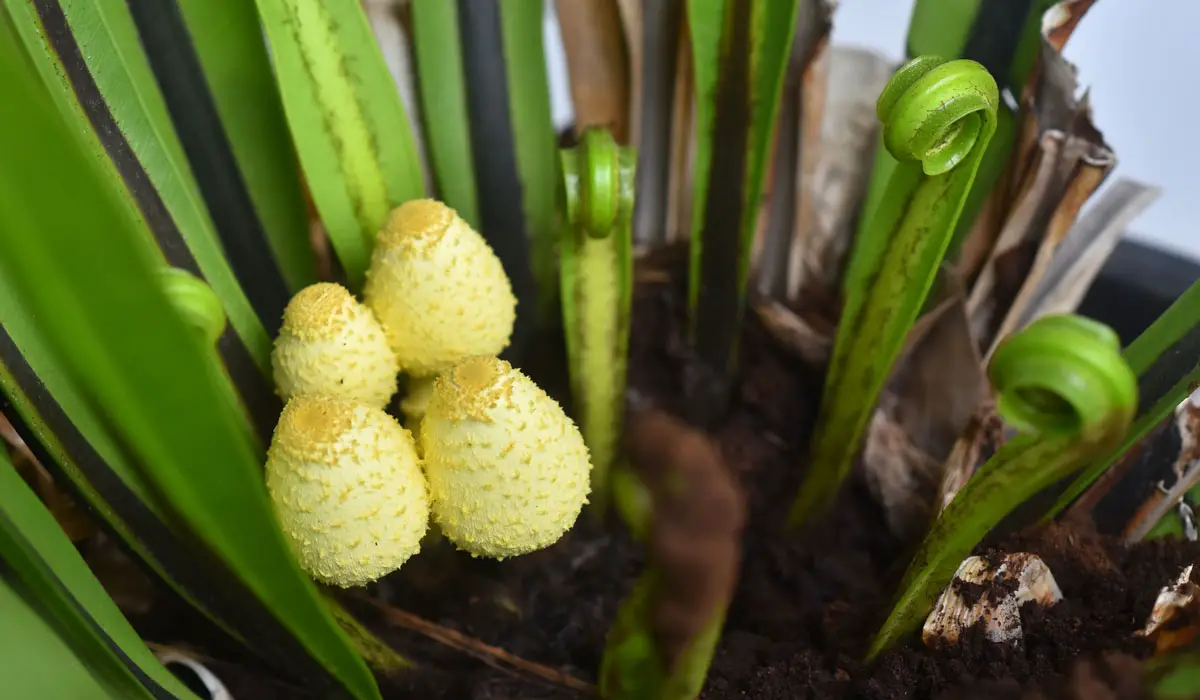
Table of Contents
Is Yellow Fungus In Soil Harmful?
Yellow fungi growing on top of your plant soil are harmless. These saprophytic fungi feed on decaying organic matter and do not go for healthy plant parts. Additionally, the appearance of yellow fungus can help you by signaling that the conditions in your garden are off – too moist or shaded.
How To Identify The Type Of Yellow Fungus You Have In Your Soil
Yellow fungal growth itself is hard to miss – with its bright color against the moist, dark soil, it looks almost alit.
However, not all yellow molds are the same, and some are even very distantly related. The only thing that connects them is their lively pigment.
Let’s explore the types of yellow mold you can find in your garden soil.
Mold
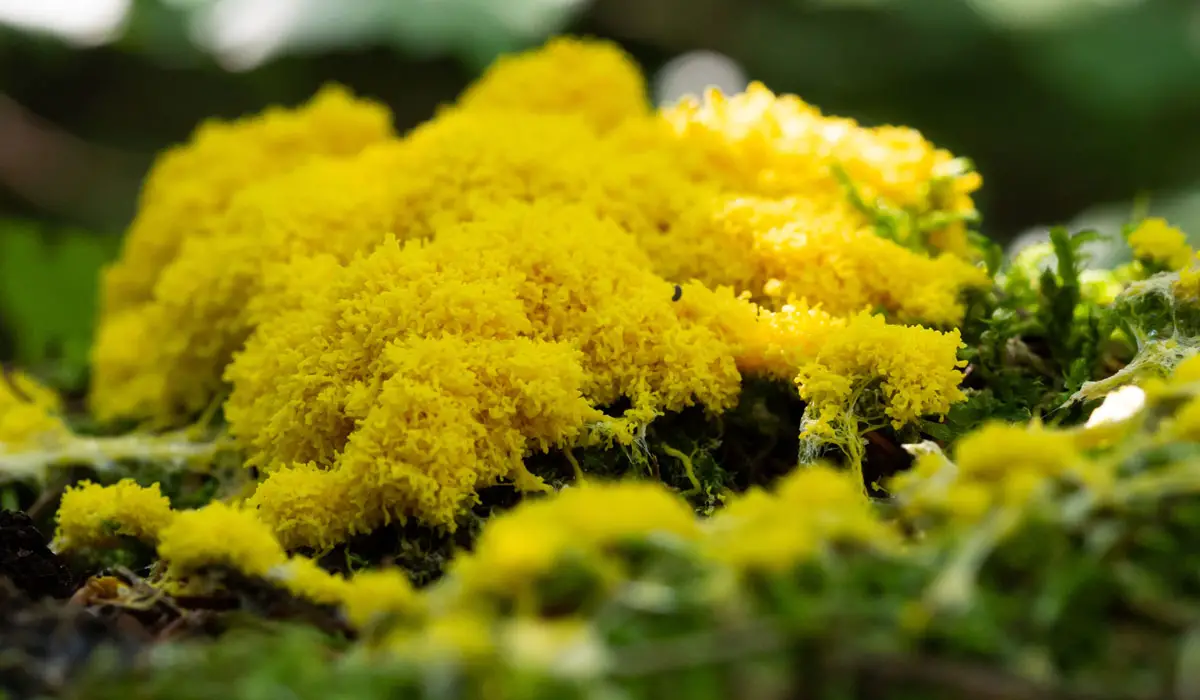
Yellow molds that appear as patches on the top of the soil are actually the beginning stages of the following two species: the yellow parasol mold (Leucocoprinus birnbaumii) that will produce mushrooms, or the Dog vomit slime mold, Fuligo septica. The latter is not a true fungus at all – read on to find out more!
There may be more yellowish mold species that can randomly occur on top of the garden soil; however, these two are the most common and the most interesting types.
Mushrooms
Pot mushrooms in my grandmother’s seasoned rubber fig pot were my first up-close encounter with the iconic fungal structures I only used to see in cartoons. It made such an impression on me that despite being so little – I vividly remember suddenly noticing them all those years ago.
Although there are many species of yellow mushrooms outdoors, the type we see in the flower pots indoors is only one species – the yellow houseplant mushroom (Leucocoprinus birnbaumii), also known as the yellow parasol, or flower pot parasol.
It is a yellow and white fungus that starts as a typical moldy, woolly yellow patch. In time, it will start producing bright yellow mushrooms with small, round tips. As the mushroom grows, the tip will open into a broad parasol, and the now-large mushroom will become white.
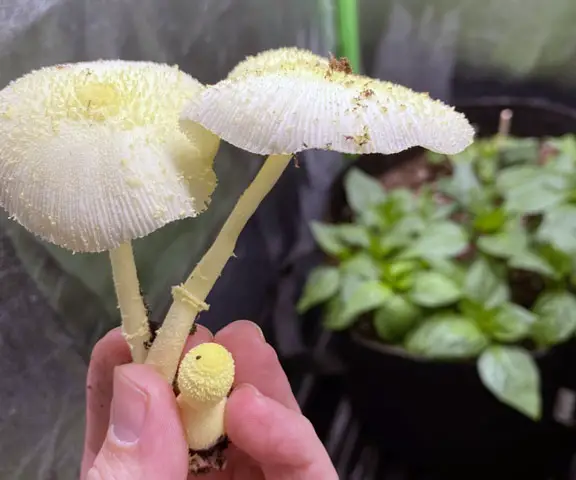
Should I Remove Yellow Mushrooms From My Plant Pot?
Although views differ, in my humble opinion, the yellow houseplant mushroom can create quite an attractive display.
If you have a small child or a curious mouthy dog, removing the mushrooms is the best course of action. However, if your kids are older, they may enjoy the new pot tenant – take the first paragraph as proof.
Still, with small kids and animals, you can’t guarantee that ingestion won’t happen, so err on the side of caution and remove the mushrooms as they appear.
Slime Mold
If your inner child is at least a bit alive, it is sure that you will find both the sight and name of this common yellow garden slime funny. The Dog vomit slime mold, Fuligo septica, really looks like its name suggests – the uneven sulfur-yellow hue, irregular shape, and seemingly random appearance on the ground will surely make you suspect the real doggy puke.

This creature is weird when you look at it as a layman but for an expert biologist too.
What is so strange about dog vomit slime mold in terms of biology is that it’s not a typical mold or a typical fungus. It belongs to the separate slime mold phylum, Myxomycetes, which is a unique category of creatures that are neither plants, animals, nor true fungi. Instead of mushrooms, it forms a plasmodium – an aggregate of undifferentiated cells that can move like amoebas to search for food.
What we see as “dog vomit” is precisely the mold’s plasmodium – the organism’s moveable headless, formless body.
The dog vomit mold most commonly grows on wood debris, so if you have a food forest, woodland garden, or bark-mulched patches, the higher the chances it will appear on your property. It is harmless, although the spores can cause allergy symptoms in susceptible individuals.
The Dog vomit slime mold plasmodium can have an interesting shape, leading us to the next section.
Mold Eggs or Balls
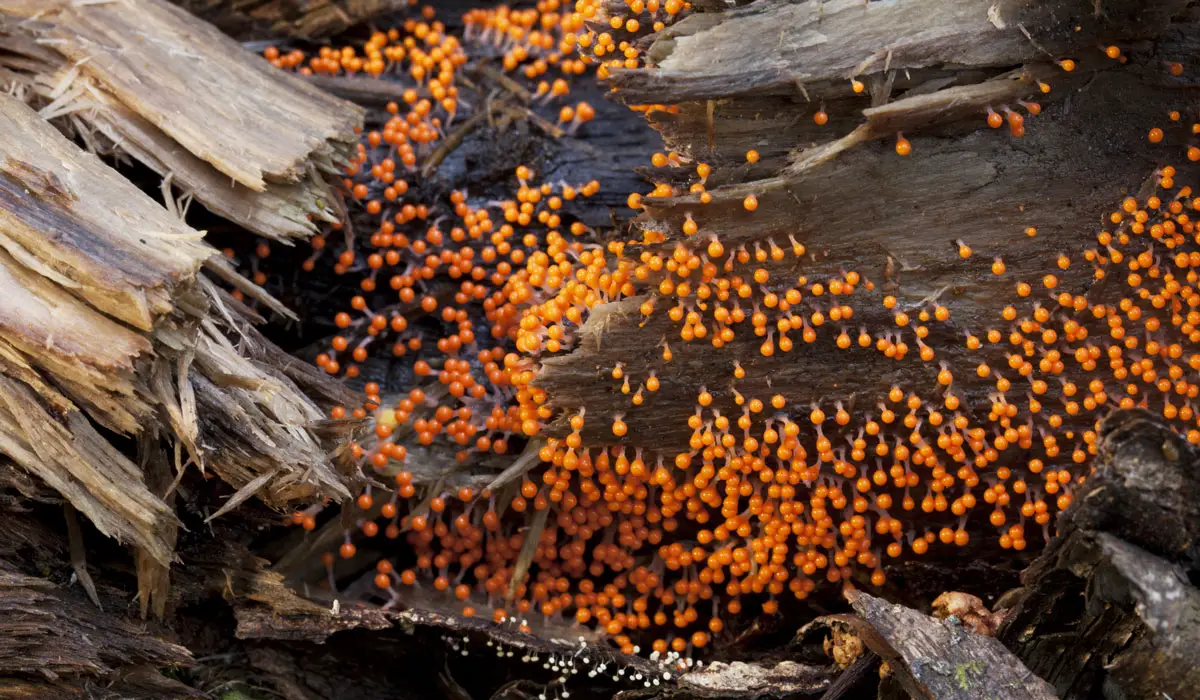
If you find a globular yellowish moldy structure, the chances are it is an interestingly shaped dog vomit slime mold. As it matures, the plasmodium gets bigger and can have a shape of an egg or a ball – or several eggs and balls.
The final spore-bearing stage called aethalia can have the same rounded shape, but the color will be orange at first and then brown at the end of the cycle.
How long does it live in soil?
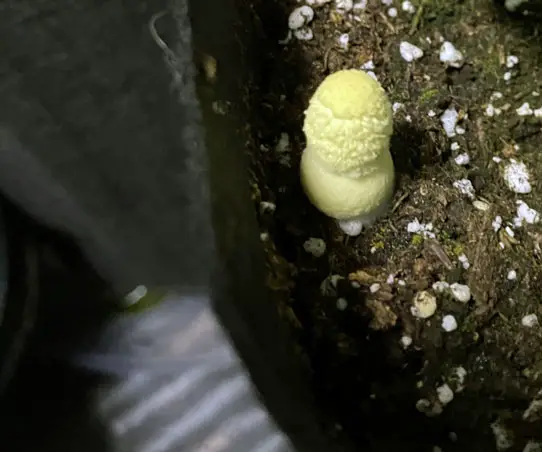
In time, Fuligo septica’s plasmodium body will turn into aethalia – an accumulation of spores which is essentially the dried plasmodium, brown in color. As the aethalia degrades, the spores spread around the environment, and that’s the end of the cycle. The mold essentially disappears but may appear elsewhere when the conditions are right.
The whole cycle, from the appearance of the first yellow patches to aethalia degradation, takes only several days (depending on the weather and growing conditions). However, the spores will persist in the environment indefinitely.
Steps To Get Rid Of Yellow Fungus Naturally
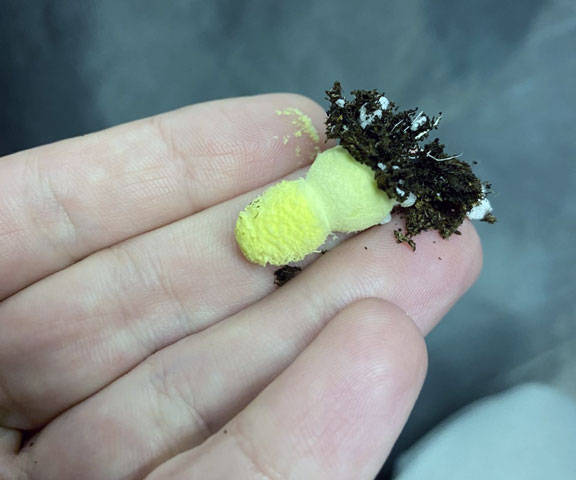
If you find the yellow fungal growth around your plants unsightly or you don’t want to think about the possible consequences, there are ways to remove the fungus naturally.
Physically remove the mold
For molds, scoop up the upper layer of the soil – around 2 centimeters or a bit less than an inch – and replace it with fresh, uncontaminated soil. This simple maneuver could get you rid of the fungus for good.
For mushrooms, remove them as they appear, and then scoop up the upper layer of the soil as in the case of molds – even if the moldy growth at this point is not visible.
Use a natural antifungal solution
Home-made antifungal solutions can be made from common ingredients.
- Baking soda: 1 tablespoon of baking soda dissolved into 2 liters of water
- Table vinegar: first, try with a 1:1 vinegar-water solution. If it doesn’t work, spray the pure table vinegar over the fungus.
- A few drops of neem oil dissolved in water also act as an antifungal.
Repot the plant
If nothing works, simply repot the plant into the new soil. As the mold does not attach itself to living plant tissues, the new pot will be fungus-free by default. However, the spores can remain in the environment, so it’s important to take care of the fungus-favoring conditions.
Take care of the conditions that lead to the appearance of mold
In this crucial step, ensure that you improve the growing conditions for the plants. Larry Hodgson recommended these steps:
- Let the soil dry out between waterings
- Increase air circulation
- Avoid dense, heavy soils
- Remove fallen leaves or other debris
- Replant plants growing in pots without drainage holes into more appropriate containers
- Increase light levels
- Remove mulch
- Apply a fungicide (a commercial one, do this only as the last resort).
Final thoughts
As you see, yellow molds are not dangerous to plants, are seldomly a hazard to humans, and can be an interesting phenomenon to observe in your garden. Of course, the final risk assessment and the decision of whether you want to keep it or remove it is up to you. I hope that this article will help you make the choice easier for you.

Before you go!
A complete guide to blood meal: Uses and precautions
Humic Acid Fertilizer For Plants: A Complete Guide
Is Rice Water Good For Plants Or Will It Harm Them?
What is 14-14-14 fertilizer good for? A complete Guide